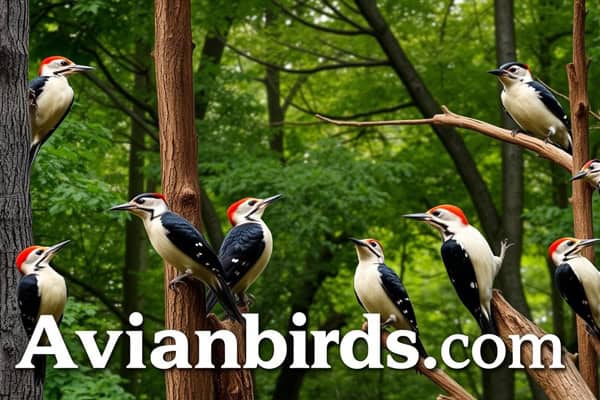13 Sparrows in Ohio (With Pictures)
Sparrows in Ohio captivate me. Tiny birds fly around in fields, singing their songs that make life like a beautiful picture. Moreover, studied these small birds and found out interesting things about them. From the melodic trill of the Field Sparrow to the whistle-like notes of the White-throated Sparrow, each has a story. In spring, they arrive, migrating to breed or passing through. Juncos and Towhees join the chorus. Have you ever noticed those small brown birds hopping around in your backyard? Also, They love munching on seeds and bugs, adding charm to our outdoor spaces. So, Let’s explore Ohio’s sparrows. They’re lively little singers that definitely need our notice. Plus, they’re fascinating to learn about.
Here are the main points:
- Ohio is home to a diverse range of sparrow species.
- Ohio’s sparrows offer a unique opportunity to observe their beauty and behaviors.
- There are understated differences between various sparrow species that make each one special.
- Photos will help you identify sparrows during your birding adventures in Ohio.
- Go on board on a journey through Ohio’s sparrow-filled habitats and witness the state’s rich avian biodiversity.
Ohio’s Common Sparrow Species
Hey there, if you really like birds and live in Ohio, you’re in for a treat! Ohio has lots of different kinds of sparrows that you can see in all sorts of places. Let’s check out some cool birds like the song sparrow, house sparrow, swamp sparrow, dark-eyed junco, and white-throated sparrow. They’re pretty neat
1. Song Sparrow
- Scientific name: Song Sparrow
- Average Lifespan: 2-7 years
- Size: 5.5-7 inches (14-18 cm)
- Weight: 0.8-1.4 ounces (22-40 grams)
- Wingspan: 9.1-9.8 inches (23-25 cm)
- Conservation Status: Least Concern
- Year-Round Presence: Yes
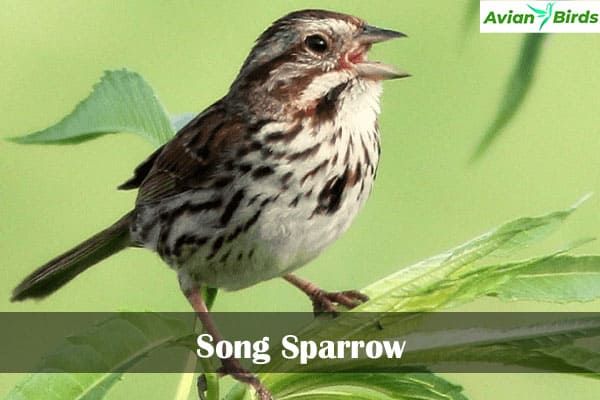
The song sparrow (Melospiza Melodia) is a familiar sight in Ohio’s woodlands, grasslands, and marshes. With its distinctive streaked brown plumage and a melodic song that fills the air, this sparrow is a delight to observe. It forages on the ground for seeds, insects, and small invertebrates and can be found year-round in Ohio.
2. House Sparrow
- Scientific name: Passer domesticus
- Average Lifespan: 3-5 years
- Size: 5.5-6.3 inches (14-16 cm)
- Weight: 1.1-1.4 ounces (30-40 grams)
- Wingspan: 7.9-9.1 inches (20-23 cm)
- Conservation Status: Least Concern
- Year-Round Presence: Yes
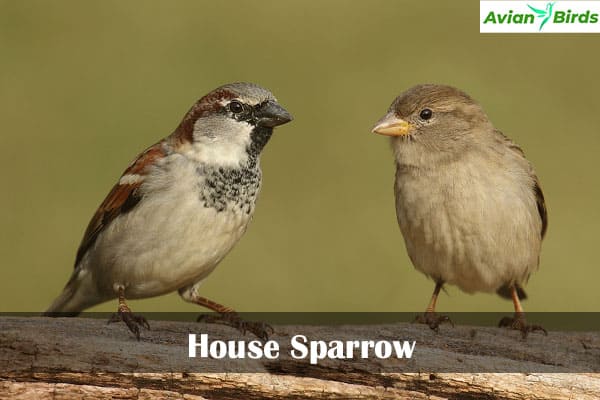
The house sparrow (Passer domesticus) is easily recognized by its gray plumage, black bib, and the male’s vibrant brown and black head pattern. Native to Europe, Asia, and North Africa, this introduced species has adapted well to urban and suburban environments. House sparrows can be found throughout Ohio, nesting in buildings and foraging for seeds, grains, and scraps.
3. Swamp Sparrow
- Scientific name: Melospiza georgiana
- Average Lifespan: 2-4 years
- Size: 5.5-6.3 inches (14-16 cm)
- Weight: 0.7-1.2 ounces (20-35 grams)
- Wingspan: 8.7-9.1 inches (22-23 cm)
- Conservation Status: Least Concern
- Year-Round Presence: Yes
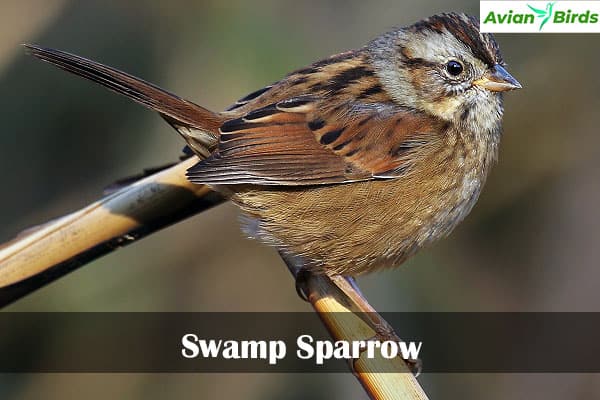
The swamp sparrow (Melospiza Georgiana) is a secretive sparrow that inhabits wetland areas across Ohio. Its dark-streaked brown plumage and rusty cap make it stand out among its fellow sparrows. With a characteristic trill call, this sparrow can often be heard before it is seen. It feeds on insects, seeds, and aquatic vegetation, and nests in dense marshes.
4. Dark-eyed Junco
- Scientific name: Junco hyemalis
- Average Lifespan: 3-7 years
- Size: 5.5-6.3 inches (14-16 cm)
- Weight: 0.7-1.1 ounces (20-30 grams)
- Wingspan: 7.5-9.8 inches (19-25 cm)
- Conservation Status: Least Concern
- Winter Presence: Yes
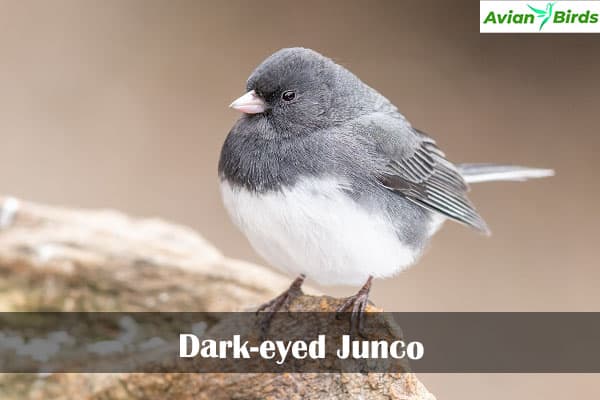
The dark-eyed junco (Junco hyemalis) is a common winter visitor in Ohio. Its plumage varies based on geographic location, but most individuals have a dark gray or brown back and a white belly. These ground-foraging sparrows can often be seen in flocks, feeding on seeds and grains. As spring approaches, they begin their northward migration to breed in more northern regions.
5. White-throated Sparrow
- Scientific name: Zonotrichia albicollis
- Average Lifespan: 5-10 years
- Size: 6.3-7.5 inches (16-19 cm)
- Weight: 0.9-1.3 ounces (25-38 grams)
- Wingspan: 8.7-9.8 inches (22-25 cm)
- Conservation Status: Least Concern
- Winter Presence: Yes
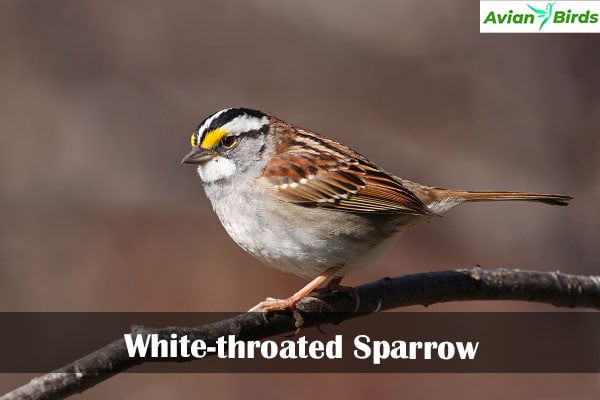
The white-throated sparrow (Zonotrichia albicollis) is a beautiful sparrow with bold black and white markings and a distinct song that sounds like “Oh, sweet Canada, Canada, Canada.” This species breeds in the boreal forests of Canada but visits Ohio during its spring and fall migrations, highlighting how sparrows are common in Ohio. It can often be found scratching through leaf litter in search of insects and seeds.
Now that we’ve introduced you to Ohio’s common sparrow species, you’ll be able to spot these wonderful birds during your birding adventures. Check out the table below for a quick comparison of their key features:
| Sparrow Species | Appearance | Habitat | Feeding |
|---|---|---|---|
| Song Sparrow | Streaked brown plumage | Woodlands, grasslands, marshes | Seeds, insects, invertebrates |
| House Sparrow | Gray plumage with black bib | Urban, suburban areas | Seeds, grains, scraps |
| Swamp Sparrow | Dark-streaked brown plumage | Wetlands, marshes | Insects, seeds, aquatic vegetation |
| Dark-eyed Junco | Dark gray or brown back, white belly | Winter visitor | Seeds, grains |
| White-throated Sparrow | Black and white markings | Migratory visitor | Insects, seeds |
Now that you have a better understanding of Ohio’s common sparrow species, you can confidently identify and appreciate these beautiful birds in the wild.
Sparrows of Ohio’s Grasslands and Fields
Ohio’s grasslands and fields are vibrant habitats that attract a variety of sparrow species. Among the numerous species found in these open landscapes are the American tree sparrow, chipping sparrow, eastern towhee, field sparrow, savannah sparrow, and grasshopper sparrow.
The American tree sparrow (Spizella arborea) is a small sparrow with distinct rusty-colored caps and a gray chest. During the winter months, these sparrows can be seen in Ohio’s grassy fields, foraging for seeds and insects.
The chipping sparrow (Spizella passerina) is known for its distinctive song, often described as a repetitive “chip” or “chipping.” These sparrows are commonly found in open areas with shrubs and trees, where they build their cup-shaped nests.
“The chipping sparrow’s sweet, song-like trill always brings a smile to my face as I wander through Ohio’s fields.” – John, avid birder
The eastern towhee (Pipilo erythrophthalmus) is a striking sparrow species with a black head, red eyes, and rufous sides. They prefer shrubby habitats within grasslands and fields, where they can easily conceal themselves.
The field sparrow (Spizella pusilla) is a small sparrow with a pink bill and a distinct white eye ring. These sparrows are commonly found in grassy fields and meadows, singing their melodic songs from perches or on the ground.
The savannah sparrow (Passerculus sandwichensis) is a sparrow species known for its streaky brown and yellow plumage. They thrive in open grasslands and fields, where they forage for insects and seeds.
The grasshopper sparrow (Ammodramus savannarum) is a small sparrow with a unique buzzing song that resembles the sound of grasshoppers. They prefer grassy areas with dense vegetation and are known for their secretive nature.
Tips for Spotting These Sparrows in Ohio
If you’re eager to observe these sparrows in Ohio’s grasslands and fields, here are some helpful tips:
- Visit natural reserves and parks with open grassy areas, such as prairies or meadows.
- Look for sparrows perched on fence lines, shrubs, or tall grasses.
- Pay attention to their distinct songs and calls.
- Bring a pair of binoculars for a closer look.
By exploring Ohio’s grasslands and fields, you’ll have the opportunity to encounter these fascinating sparrow species in their natural habitats.
Sparrows of Ohio’s Wetlands and Marshes
In the wetlands and marshes of Ohio, you’ll find a variety of sparrow species that have adapted to thrive in these unique habitats. Let’s explore the characteristics, preferred habitats, and distinct behaviors of the Henslow’s sparrow, vesper sparrow, lark sparrow, white-crowned sparrow, and Lincoln’s sparrow.
Henslow’s Sparrow
The Henslow’s sparrow is a small, secretive sparrow with a distinctive song that consists of a series of staccato notes. This species prefers tall grasses and dense vegetation in wetland areas, a habitat commonly associated with LeConte’s Sparrow. Keep an eye out for its olive-brown plumage and black streaks on its back.
6. Vesper Sparrow
- Scientific name: Pooecetes gramineus
- Average Lifespan: 2-5 years
- Size: 5.9 inches (15 cm)
- Weight: Varies
- Wingspan: 8.7-9.8 inches (22-25 cm)
- Conservation Status: Least Concern
- Summer Presence: Yes

The vesper sparrow is known for its melodious song that can often be heard in the evening. This sparrow can be found in open habitats with dense grasses or shrubs. Look for its streaked back, white outer tail feathers, and yellowish eyebrow stripe.
7. Lark Sparrow
- Scientific name: Chondestes grammacus
- Average Lifespan: 4-6 years
- Size: 5.9-6.7 inches (15-17 cm)
- Weight: 0.7-1.1 ounces (20-31 grams)
- Wingspan: 9.1-10.2 inches (23-26 cm)
- Conservation Status: Least Concern
- Summer Presence: Yes
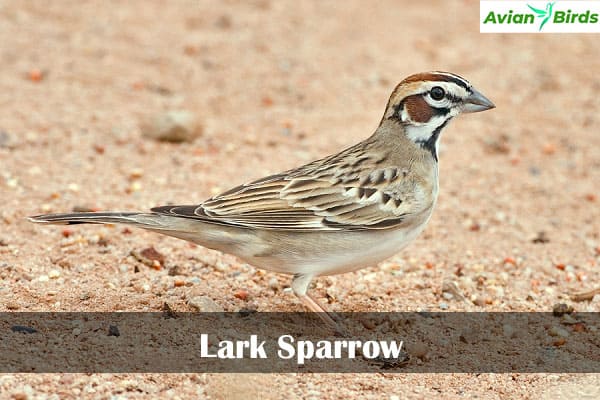
The lark sparrow stands out with its attractive plumage featuring bold patterns of black, white, and chestnut. This species prefers open grasslands and prairies, including wetland edges. Look for its distinctive black face mask and white corners on its tail feathers.
8. White-crowned Sparrow
- Scientific name: Zonotrichia leucophrys
- Average Lifespan: 6-13 years
- Size: 6.7-7.9 inches (17-20 cm)
- Weight: 0.9-1.4 ounces (26-40 grams)
- Wingspan: 9.8-11.8 inches (25-30 cm)
- Conservation Status: Least Concern
- Migration Presence: Yes
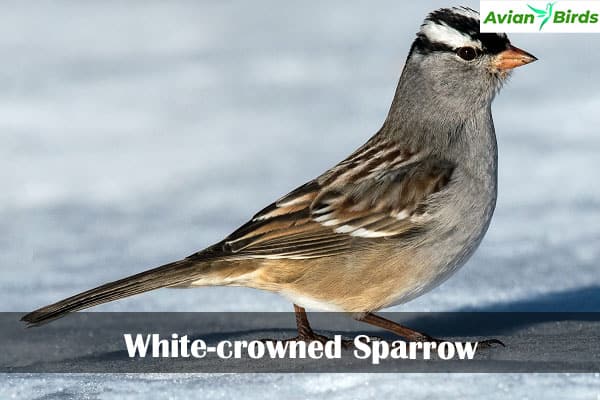
The white-crowned sparrow is easily identified by its striking black and white striped crown. This species can be found in a variety of habitats, including wetlands and marshes, where it forages for seeds and insects. Listen for its clear, whistling song.
9. Lincoln’s Sparrow
- Scientific name: Melospiza lincolnii
- Average Lifespan: 3-5 years
- Size: 4.7-5.9 inches (12-15 cm)
- Weight: 0.4-0.6 ounces (12-18 grams)
- Wingspan: 7.1-7.9 inches (18-20 cm)
- Conservation Status: Least Concern
- Migration Presence: Yes
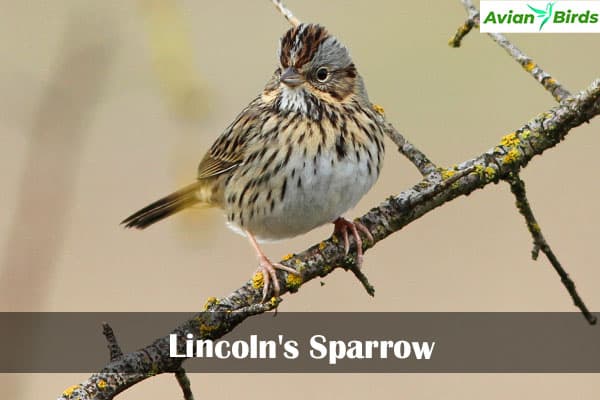
The Lincoln’s sparrow is a small, insectivorous bird with a buff-colored breast and intricate brown streaks on its back. While it prefers wet meadows and marshes, you may also spot it in brushy areas near water. Listen for its soft, high-pitched trill.
Exploring Ohio’s wetlands and marshes will provide you with the opportunity to encounter these fascinating sparrow species in their natural habitats. Remember to bring your binoculars and field guide to enhance your birding experience. Happy birding!
Sparrows with Unique Features
Ohio is a haven for bird enthusiasts, offering a diverse range of sparrow species with unique features. Let’s delve into the distinctive characteristics, habitats, and behaviors of four captivating sparrows that call Ohio home: the Fox sparrow, Nelson’s sparrow, Clay-colored sparrow, and Le Conte’s sparrow.
10. Fox Sparrow
- Scientific name: Passerella iliaca
- Average Lifespan: 3-6 years
- Size: 6.7-7.9 inches (17-20 cm)
- Weight: 1.4-1.8 ounces (40-52 grams)
- Wingspan: 10.2-11.8 inches (26-30 cm)
- Conservation Status: Least Concern
- Migration Presence: Yes
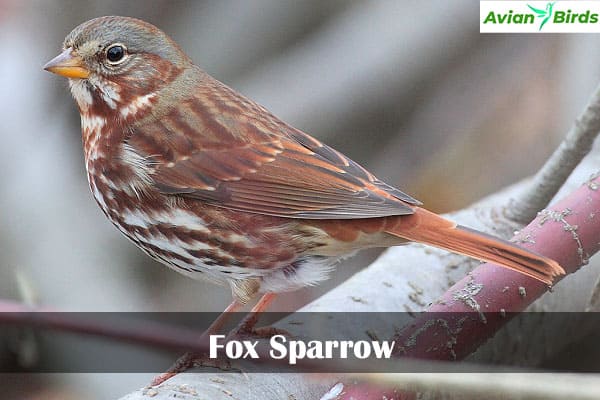
The Fox sparrow (Passerella iliaca) boasts a striking reddish-brown plumage, similar to that of a fox. These large and stocky sparrows are often found in woodland areas with dense undergrowth. Their melodious song, consisting of notes followed by a rich trill, is a true delight to the ears.
11. Nelson’s Sparrow
- Scientific name: Ammospiza nelsoni
- Average Lifespan: 2-3 years
- Size: 4.7-5.5 inches (12-14 cm)
- Weight: 0.4-0.6 ounces (12-18 grams)
- Wingspan: 6.7-7.5 inches (17-19 cm)
- Conservation Status: Near Threatened
- Migration Presence: Yes

The Nelson’s sparrow (Ammodramus nelsoni) displays a beautiful combination of gray, brown, and reddish colors, with a distinctive facial pattern. The secretive nature of this sparrow makes it a challenge to spot. Look for them in wet meadows and marshes, where they build their cup-shaped nests among cattails and other vegetation.
12. Clay-colored Sparrow
- Scientific name: Spizella pallida
- Average Lifespan: 4-7 years
- Size: 4.7-5.9 inches (12-15 cm)
- Weight: 0.4-0.7 ounces (12-20 grams)
- Wingspan: 7.1-7.9 inches (18-20 cm)
- Conservation Status: Least Concern
- Migration Presence: Yes
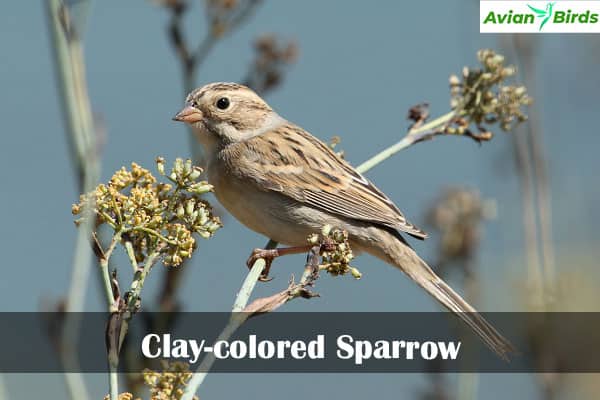
The Clay-colored sparrow (Spizella pallida) is a small but stunning sparrow with a plumage that ranges from pale brown to grayish. Their song is a soft, melodic trill that fills the air of grassy fields and prairies. Keep an eye out for their unique facial pattern, with a distinct dark eyeline.
13. Le Conte’s Sparrow
- Scientific name: Ammospiza leconteii
- Average Lifespan: 2-3 years
- Size: 4.3-5.1 inches (11-13 cm)
- Weight: 0.4-0.6 ounces (12-18 grams)
- Wingspan: 5.9-6.7 inches (15-17 cm)
- Conservation Status: Least Concern
- Migration Presence: Yes
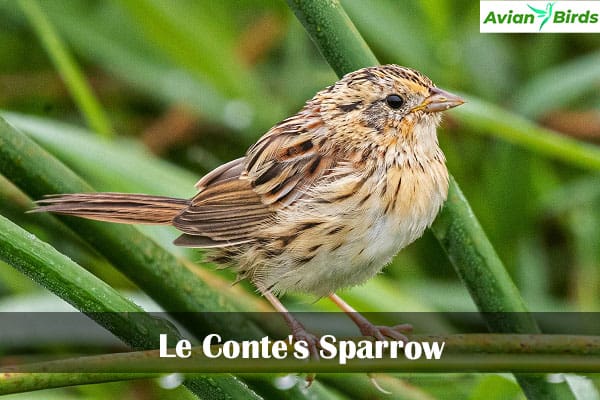
The Le Conte’s sparrow (Ammodramus leconteii) is a well-camouflaged species with subtle shades of brown and gray. Known for their distinctive buzzing song, these sparrows prefer tall grasses and wet meadows as their habitat. Patient birders may be rewarded with a glimpse of their intricate mating display, where males ascend into the sky and produce a harmonious combination of vocal trills and descending flight.
These four sparrow species embody the diverse avian beauty that can be found in Ohio. Their unique features, habitats, and behaviors make them a true delight for birdwatchers and nature enthusiasts. Stay tuned as we continue our exploration of Ohio’s fascinating sparrow species in the upcoming sections!
Sparrows in Ohio’s Migration Seasons
Ohio is a crucial stopover for sparrows during their fall and spring migrations, making it an ideal destination for birders and nature enthusiasts. These migratory seasons bring an influx of sparrows, creating opportunities to witness the majestic phenomenon of mass bird movements.
Fall migration is an exciting time when sparrows journey southward from their breeding grounds in search of warmer climates and abundant food sources. As the days grow shorter and temperatures drop, sparrows embark on their long-distance journey, covering vast distances to reach their wintering grounds.
Spring migration, on the other hand, marks the return of sparrows to their breeding grounds after spending the winter months in more southern regions. With the arrival of spring, migrating sparrows make their way north, driven by the instinct to find suitable nesting territories and optimal conditions for raising their young.
“The sight and sounds of sparrows migrating during these seasons are truly remarkable. Watching them crossing vast distances, forming flocks, and filling the sky with their calls is an awe-inspiring experience,” says ornithologist Dr. Jane Wilson.
During the fall migration, birders in Ohio can expect to witness diverse sparrow species on their journey southward. Some of the sparrows commonly seen during this season include the White-throated Sparrow, Swamp Sparrow, and Dark-eyed Junco. These birds take advantage of Ohio’s diverse habitats, such as woodlands, fields, and wetlands, as they make their way to their wintering grounds.
Spring migration in Ohio offers a chance to witness the return of sparrows as they move northward, showcasing types of sparrows in Ohio. Species such as the Song Sparrow, Chipping Sparrow, and Savannah Sparrow can be spotted during this time, bringing their beautiful melodies back to Ohio’s landscapes.
Best Times and Places to Observe Sparrow Migration in Ohio
To maximize your chances of witnessing the spectacular sparrow migration in Ohio, timing and location are crucial. The peak of fall migration typically occurs in September and October, while the spring migration reaches its peak in April and May.
Some of the best locations to observe sparrow migration in Ohio include Magee Marsh Wildlife Area, Ottawa National Wildlife Refuge, and Lake Erie Metropark. These areas provide important stopover points for migrating sparrows and offer ideal habitats for feeding and resting.
It’s worth noting that weather conditions, including winds and weather fronts, can greatly influence sparrow migration patterns. Birders should keep an eye on weather forecasts and be prepared for sudden changes, as these conditions can concentrate sparrows into specific areas and increase the chances of impressive migratory movements.
Ohio’s fall and spring migrations offer incredible opportunities to witness the beauty and resilience of sparrows as they undertake their long journeys. By understanding their migration patterns, exploring suitable habitats, and keeping an eye out for the right timing, birders can immerse themselves in the mesmerizing world of sparrow migration in Ohio.
Sparrow Habitats and Nesting Behaviors
Understanding sparrows’ preferred habitats and nesting behaviors is crucial for birders in Ohio. Sparrows are adaptable birds, found in a variety of habitats throughout the state.
Habitat
Sparrows can be found in a range of habitats, including grasslands, fields, wetlands, marshes, woodlands, and suburban areas. Each species has its own specific habitat preferences, allowing for a diverse and thriving sparrow population in Ohio.
Nesting Behaviors
Sparrows construct nests using a variety of materials such as twigs, grass, and feathers. These nests are typically located in low vegetation, such as shrubs or grasses, providing protection and camouflage. Female sparrows are primarily responsible for nest building.
Once the nest is constructed, female sparrows lay their eggs and incubate them until they hatch. The number of eggs in each clutch varies by species, ranging from 3 to 6 eggs. Both male and female sparrows share the responsibility of feeding the chicks after they hatch.
Interactions with Feeders
Sparrows are opportunistic feeders and can be attracted to backyard bird feeders. Providing sparrows with suitable food options, such as seeds and grains, can encourage them to visit your feeder. However, it’s important to note that sparrows can be aggressive towards other bird species and may dominate the feeder.
“Sparrows are adaptable birds that can thrive in a variety of habitats, and understanding their nesting behaviors can enhance our appreciation for these fascinating creatures.” – Ohio Birding Society
Sparrow Identification Tips and Behaviors
Identifying sparrows can be challenging due to their similarities, but by learning key behaviors and identification tips, birders can become experts at recognizing different species. Understanding the foraging habits, distinct calls, vocalizations, and physical characteristics of sparrows can greatly aid in accurate identification.
When it comes to foraging, sparrows are often found in grassy areas, such as fields and meadows, where they search for insects, seeds, and berries. They use their sharp bills to extract seeds from grass heads and forage on the ground for insects and other small arthropods. Watching sparrows forage can provide valuable clues about their species, as different sparrows have unique foraging techniques and preferences.
Vocalizations and Calls
Sparrows are known for their distinctive calls and songs. Understanding these vocalizations can help birders identify different species. For example, the song Sparrow is known for its melodic and varied trill, while the chipping sparrow has a distinctive three-note chip call. The field sparrow, on the other hand, has a sweet, high-pitched song that is often described as a clear whistle.
“The song sparrow’s beautiful trill can often be heard in woodland and suburban areas, filling the air with its melodious notes.”
Distinct Physical Characteristics
Examining the physical characteristics of sparrows can also aid in species identification. Look for unique markings, patterns, and colors. For instance, the finch-like American tree sparrow has a streaked breast and a rusty-colored cap, making it easily distinguishable from other sparrows. The white-throated sparrow stands out with its white throat patch and distinctive head markings. Taking note of these distinct features can help birders confidently identify different sparrow species.
| Sparrow Species | Foraging Habits | Vocalizations | Distinct Physical Characteristics |
|---|---|---|---|
| Song sparrow | Forages in grassy areas, ground-dweller primarily near the ground | Melodic and varied trill | Brown back with dark streaks, bold chest spot |
| Chipping sparrow | Forages on the ground, searches trees and shrubs | Distinctive three-note chip call | Rusty crown, gray underparts, black eyeline |
| Field sparrow | Forages in grassy areas, on the ground | Sweet, high-pitched song | Pink bill, white eye ring, tan back with pinkish sides |
| American tree sparrow | Forages in grassy and woodland areas | Complex song, varied calls | Rusty crown, streaked breast, gray head with reddish-brown stripes |
| White-throated sparrow | Forages on the ground, under vegetation | Whistled song, soft calls | White throat patch, black and white head stripes |
By observing sparrows’ foraging habits, listening to their calls, and noting their distinct physical characteristics, birders can develop a wealth of knowledge to identify these remarkable woodland creatures, making every birding experience a truly rewarding one.
Sparrows and Ohio’s Biodiversity
Sparrows are an integral part of Ohio’s rich avian population, contributing to the state’s biodiversity. With numerous sparrow species calling Ohio home, they play a vital role in the ecosystem. As native birds, sparrows are well-adapted to the diverse habitats found throughout the state.
One of the remarkable aspects of sparrows is their ability to thrive in suburban areas. Unlike some other bird species, sparrows have adapted well to human-altered landscapes, making them abundant and widespread in neighborhoods and urban settings. Their presence in these areas adds to the beauty and charm of suburban birding experiences.
The breeding season is a particularly important time for sparrows. During this period, they engage in courtship displays, build nests, and raise their young. The diverse sparrows found in Ohio contribute to the lively chorus of bird songs heard throughout the breeding season, enhancing the overall avian experience with notes followed by their melodious song. Additionally, sparrows often interact with other bird species, such as bluebirds and purple martins, creating fascinating dynamics within the birding community.
Sparrows, with their wide variety of species, their adaptability to suburban areas, and their significance during the breeding season, add depth and vibrancy to Ohio’s biodiversity. Whether you’re a seasoned birder or a nature enthusiast, observing sparrows and learning about their behaviors can be a fascinating and rewarding experience.
Check Our Previous Articles:
Frequently Asked Questions
Q1. What kind of sparrows live in Ohio?
House Sparrows, Song Sparrows, White-throated Sparrows, and Chipping Sparrows are common in Ohio.
Q2. Are House Sparrows invasive in Ohio?
Yes, House Sparrows are considered invasive in Ohio and many other regions.
Q3. Do sparrows in Ohio migrate?
Some sparrows in Ohio, like White-throated Sparrows, migrate seasonally, while others, like House Sparrows, tend to stay year-round.
Q4. Are sparrows good birds to have around?
Sparrows can be beneficial for controlling insect populations, but they can also be aggressive towards other bird species and may cause nuisance in certain situations




